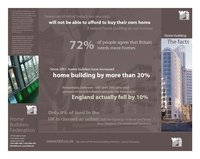The Facts on Home Building in the UK
Britain is experiencing a housing crisis
• If housing supply remains at recent
levels, there will be a shortage of
50,000 homes each year across England,
a cumulative shortfall of more than
one million homes by 2026. 1
• Seven out of ten of today’s ten year olds
will not be able to afford to buy their
own home if rates of home building
do not increase.
Everyone knows that Britain needsmore homes
• 72% of people agree that Britain needs
more homes.3
• 53% want their council to encourage
more home building in their area.
Britain’s home builders are doing their best to meet housing needs with less land
• Since 2001, when housing completions in Great Britain fell to their
lowest peacetime level since 1924, home builders have increased
home building by more than 20%. 5
• Because the supply of land has fallen, the rise in building has only
been possible because average densities have risen significantly. 6
• More than 40% of new homes in 2004/2005 were flats,
up from 20% in 2000/1.
Britain’s planning system is still not bringing enough land forward to meet housing needs
• Remarkably, between 1997 and 2003 the total amount of land
developed annually for housing in England actually fell by 10%. 8
• To meet housing needs, Britain’s planning system must make more
land available, rather than just relying on higher densities.
Home building does not pose a threat to the countryside
• Between 1997 and 2004, England’s Green Belt increased from
1,650,000 to 1,678,200 hectares (an expansion of 1.7%).
Green Belt land now comprises 13% of total land in England. 9
• The proportion of new homes built on brownfield land has
increased from 53% in 1997 to 74% in 2005, ahead of
Government targets. 10
• Only 8% of land in the UK is classed as urban, half the figure
in Holland and lower than Belgium,Denmark and Germany. 11
• Even an extra 120,000 homes being built per year in the
South East – four times the current rate – would only use
an additional 0.75% of the total land area of the South East
over the next ten years.
New homes are more environmentally friendly and sustainable than at any time in recent history
• New homes are up to six times more efficient in terms of
energy use than a home built in 1900. 13
• The new Part L of the Building Regulations introduced in
April 2006 means today’s new homes will be a further 40%
more energy efficient than those built before 2002. 14
• All new homes are now built with water meters,
reducing water usage significantly.
